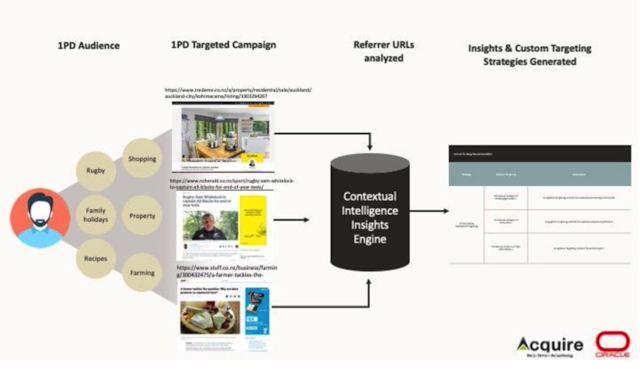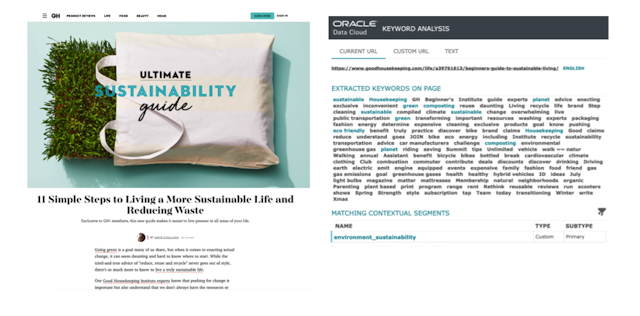Future ad strategies in a cookieless world: how Acquire NZ and Oracle are delivering precision and scale
For the past two years, the industry has been fixated on what will happen when digital advertising must become more privacy and consumer-centric, as it loosens its reliance on cookies. There has been a lot of talk about first-party data, contextual advertising and new ways of measuring, such as attention, but there are few real-life examples of these in action. That is until New Zealand-based Acquire and Oracle Advertising partnered on a mission to put these to the test with a customized, real-time campaign.

Acquire used TradeMe’s deterministic demographic audience data as an overlay
Working with a financial services client, Acquire used a range of Oracle’s solutions alongside first-party data to create highly customized contextual audience segments, while proving that this customization had a greater impact than off-the-shelf audience segments. Acquire then used the feedback loop of data to be able to optimize and create a sustainable strategy for the long-term that did not rely on third-party cookies.
Solving the cookie challenge
Commenting on how these privacy concerns have impacted the market, Zane Furtado, general manager, technology and innovation, Acquire NZ, says, “The New Zealand market is in overdrive, testing identity solutions and contextual vendors to build a framework for moving forward in the face of an industry-wide disruption (coming very soon). As marketers confront a data-deprecated world, contextual targeting is seeing a renaissance.”
One of the challenges with first-party data to solving this upcoming disruption, according to June Cheung, regional director JAPAC, Oracle, is scale. She explains: “Oracle’s contextual intelligence technology does not rely on cookies and hence is able to amplify and scale a brand’s first-party data by understanding what contextual environments their customers are most engaged with.”
With this context in mind, Acquire and Oracle have agreed to open the hood on this campaign to share the ‘how’ with the wider industry. Specifically, Acquire and Oracle set out on this mission with three defined outcomes:
-
Prove the efficiency of customized contextual targeting compared to off-the-shelf audience segments
-
Identify a way to enrich contextual targeting with the use of first- and second-party data to future-proof targeting when the cookie expires
-
Define a measurement framework that goes beyond vanity metrics
Understanding audiences on a more personal level: how to customize audience segments to get the most from contextual
The first step in this campaign was to select a technology partner and, according to Acquire, Oracle was chosen because it was a solution that offered both pre-bid contextual targeting, post-bid measurement such as viewability, brand safety, and invalid traffic (IVT) but most importantly dynamic contextual segments predicts and contextual insights based off first-party data.
The next step was to use this technology to build contextual intelligence insights but with the use of third-party cookies off the table, first-party data took centre stage. The challenge with this, however, is that a page would need to be tagged with pixels to collect and analyze data and several data layers would need to be applied. By identifying which users were converting, through referrer URL data, this data can then be used as the basis of custom contextual insights.
In terms of the layers of data used to refine these custom contextual insights and audiences, Acquire used TradeMe’s deterministic demographic audience data as an overlay, while Equifax data was used to rule out audiences with low credit scores.

Why first-party data matters: how fresh insights were gathered and scaled
Three tactics were adopted to feed Oracle’s contextual intelligence engine. Firstly, a DV360 audience profile analysis identified commonalities by creating a match between first-party data, Google’s In-Market/Affinity Segments, as well as second and third-party behavioral audience lists.
Secondly, this was layered with search intelligence gathered from the highest performing keywords across the brand’s search campaign. And finally, log-level URL data from demand-side platforms (DSPs) was used to fuel Oracle’s Contextual Intelligence Engine.
These tactics were then A/B tested against off-the shelf audiences, to understand the exact impact that this customization could bring.
Discussing the tactics that were used, Acquire’s Furtado, explains, “By running a feedback loop between Oracle and remarketing log-level referrer URLs, we were able to find non-endemic contextual categories that resonate with the user that visited the advertiser’s page.
“Non-endemic contextual opportunities like these helped us run experiments to test these new contextual categories and audiences and the results paid off in two ways. First, they help our advertisers reach consumers in these new contexts. Second, they let advertisers take advantage of media buying inefficiencies by shifting dollars to relevant non-endemic contexts.”
Custom versus off the shelf: what was learnt?
By comparing against the off-the-shelf audiences, the agency identified that the personal loan audiences indexed high with the ‘environment & sustainability’ category. In a normal scenario, the agency would not have targeted this category for the finance brand.
“I think it’s now time for brands to discard the sometimes overly simplistic preconceptions and misconceptions on their targetable audiences and let their first party data and contextual intelligence vendor help them discover new audiences for them to reach,” adds Furtado.

Optimization and the feedback loop: why continual testing is key
Acquire developed a constant impression/click DSP URL log-level feedback loop to Oracle, which meant the agency was able to constantly refine the contextual audience segments. As conversions started ramping up mid-way through the campaign, the agency started using only referrer URLs from users that converted, which allowed them to build dynamic contextual segments using Oracle’s predicts, helping to further refine audience targeting segments.
It is this dynamic aspect to contextual targeting that Oracle’s Cheung says is pushing brands to rethink their contextual targeting strategy and use dynamic context as a technology of choice for future-facing brands.
“As we move towards the cookieless future, scale will be one of the biggest challenges. An advanced contextual technology can not only find relevant content, but also be dynamic, capture trends and automatically adjust the segment based on what consumers are most engaged with and, as a result, deliver performance and scale for the brand,” she explains.
Viewability and attention: the measurement story
Another layer of the optimization was a laser focus on viewability and developing a measurement framework that went beyond vanity metrics, to fully understand what attention was given to the ads.
Using Moat post-bid campaign data to optimize, the agency identified top performing publishers that were driving viewable conversions, which helped them curate custom fixed private marketplace (PMP) deals across those publishers which helped increase viewability by 90%. Moat data also helped the agency optimize across ad size and exchanges via open exchange buys that eventually help drive better click-through rates (CTRs) and attention metrics.
It also ran an automated Moat alert system, which meant the agency could optimize the campaign in areas it saw significant variations from Moat benchmarks. After advanced supply path optimization on exchange and site, viewable conversions increased to 58%, a 45% increase.
The results
The campaign showed a 23% increase in CTR, a 35% drop in cost per acquisition (CPA) compared to off-the-shelf contextual segments, and a 7% increase in time-on-website.
For Acquire’s Furtado, this ultimately shows that even without third-party cookies, there is a scalable way to understand audiences on a more personalized level.
“Brands assume they know their audiences because grouping people into buckets is convenient,” he explains. “Advertisers need to strive to understand audiences on a more personal level. They can avoid the pitfalls that result from narrow thinking by leveraging their first party data and working with contextual vendors that can use their network and contextual intelligence engine to discover audience traits that might not have been previously identified by the brand.”
Content created with:

Oracle Advertising and CX
Oracle Advertising helps marketers use data to capture consumer attention and drive results. Used by 199 of AdAge's 200 largest advertisers, our Audience, Context,...
Find out more